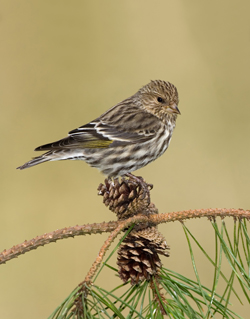 Identification
Identification
These occasional winter visitors look a bit like a House Finch, minus the red and with a dab of yellow added to the wings. Both males and females have just a hint of yellow splashed on the outer edges of their wings (males tend to have a bit more yellow).
Watch your flocks of winter finches carefully, they’re most likely made up of siskins, redpolls, juncos, goldfinches and American Tree Sparrows.
Nesting
Pine Siskins stick together in large flocks, even during breeding season, and use their numbers to help protect one another’s nests. Perhaps due to the cold climates in which they breed, the female spends as much as 90% of her time on the actual nest incubating the eggs. The male will bring her food. Of interest, and possibly again due to the cold, hatchlings have a thin downy coat when they’re born (as opposed to many songbirds who are born naked).
Range
Pine Siskins are irruptive, meaning their range shifts as they search for food. Their breeding territory also moves a bit. During years of extended migration, they may choose to stay and breed near their winter feeding grounds. Traditionally, Pine Siskins breed in the far northern reaches of Canada down to the northern Great Lakes region and upper northeast United States, through the Rocky Mountains swath, along the Pacific Coast, and are even found year-round in the mountainous region of western Mexico. Depending on food sources, they will “irrupt” throughout all of the continental U.S., except for the far southern reaches of Florida.
Diet
Flocks 30–40 of finches will descend on Nyjer® seed feeders, quickly emptying them and spilling seed to the other 20–30 Pine Siskins feeding on the ground. One of the greatest sights is a mixed flock of winter finches literally covering the ground under your feeders. They’ll also consume small sunflower chips, supplementing their diet in the summer with insects and tree buds.

